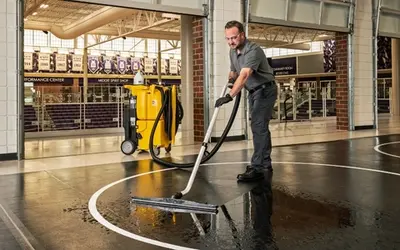The Best Way to Train Cleaning Staff

Finding the best way to train cleaning staff means diving into the science of how people learn. After all, not everyone absorbs information in the same way. There has been much debate around different styles including the learning pyramid which poses that people learn best by doing, and kinesthetic learning, that suggests some people require whole-body movement to process any new information.
As the science continues to evolve, one thing becomes clear. The best way to train cleaning staff includes a mix of traditional instruction, on-the-job learning, and access to reference materials.
Here’s what the science says and how to find tools to maximize custodial worker success.
Active Learning Beats Traditional Lectures
This study, from the The Harvard Gazette, shows that students learn more in an active classroom that promotes participation—even if the students insist that they prefer traditional lectures.
“Often, students seemed genuinely to prefer smooth-as-silk traditional lectures,” says the paper’s lead author Louis Deslauriers. “We wanted to take them at their word. Perhaps they actually felt like they learned more from lectures than they did from active learning.”
Those feelings were patently wrong. Deslauriers work showed that these students absorbed more in classrooms that employed active-learning strategies. These strategies include group discussions, peer reviews, and using hands-on technology.
This same theory applies to janitorial training. Lectures should still play a role, albeit a small one. This helps avoid what janitorial trainer Mickey Crowe calls a “data dump” where lectures cover so much information that attendees are overloaded with details that may or may not make sense.
Trainers should instead move to hands-on exercises as quickly as possible. This gives students a better feel for the equipment, the process, and a faster path to mastery.
Training Plans, the “Curse of Knowledge” and Open Book Testing
Need another reason to stress hands-on training? This study, published in the Journal of Experimental Psychology, shows that people regularly over estimate their knowledge of a topic while studying it, but often cannot recall that information when tested later.
Study author Asher Koriat, PhD, University of Haifa calls this the “Curse of Knowledge. [Students] judge that they’ve learned an answer but fail to discount the fact that the answer is in front of their face,” Koriat says. “They don’t realize that it won’t be in front of them on test day.”
To discount this bias Koriat suggests self-testing to drill information. But other strategies recommend leaving those answers in plain sight. Open book testing, where students have access to the information, may improve results and help students retain even more knowledge.
Open book testing has a lot of advantages over closed book exams, as laid out in this Washington Post article. The piece finds that:
- Test format (open vs closed book) produces little difference in learning or assessment
- Open book tests generate less anxiety in students
- Open book tests can promote the development of higher-order thinking and problem-solving skills
- Open book exams more closely replicate real world tasks
That last bullet may be the most relevant to janitorial training.
Finding the Best Way to Train Cleaning Staff
It’s unreasonable to expect new janitorial staff to learn every aspect of the trade from behind a desk. Even if they could survive the “data dump,” training sessions are limited, and new hires need to be up to speed right away.
There are plenty of tips on how to train staff quickly and efficiently. But the best way to train cleaning staff combines hands-on learning with an open book format. Even better is offering an opportunity to bring that open book out in the field so cleaners can be sure they are following proper procedure.
Lugging big binders to jobs may be more cumbersome than effective. But using an on-board video-based training device like KaiTutor™ can reinforce skills and encourage mastery right on the spot.
Similar to an iPad, this tool is loaded with videos that show clear, step-by-step instructions on how to use the Kaivac cleaning system. Workers first watch an expert use the tool. They then can pause the video and practice the skill themselves. This active learning process improves self-reliance and builds confidence. Because the information is video based, the tool works well for visual learners and minimizes language barriers.
Training will always be an important part of any worker’s success. But the stakes are higher with cleaning personnel. Proper training is vital to preventing accidents, eliminating dangerous cross-contamination situations, and delivering sparkling clean, safe interiors.
Don’t data dump. Arm workers with hands on tools like KaiTutor for reliable, repeatable, consistently clean results.
Related Posts

A Cleaning Lesson from Schools and Universities that Rely on Kaivac Systems
School, college, and university facilities departments from around the country love their Kaivac Cleaning Systems. Why wouldn’t they? Designed with the custodial worker in mind, these tools and processes from Kaivac are easy to master, work super-fast, and deliver exceptionally clean, fresh-smelling spaces.
Read more
Reduce Absenteeism Through Better School Cleaning
K-12 school leaders are coming up with a variety of ways to combat chronic absenteeism. Strategies like offering in-school laundry services and basic health care show a lot of promise. But providing better cleaning may be one of the most effective, most cost-efficient tactics available.
Read more
Top Five Cleaning Challenges Facility Managers Face—And How to Solve Them Fast
Today’s facility professionals face tons of facility cleaning challenges. Surprisingly (or not surprisingly), these janitorial pain points remain pretty consistent over the years. Here’s the top five cleaning challenges facility managers face and how tools from Kaivac can solve them.
Read more